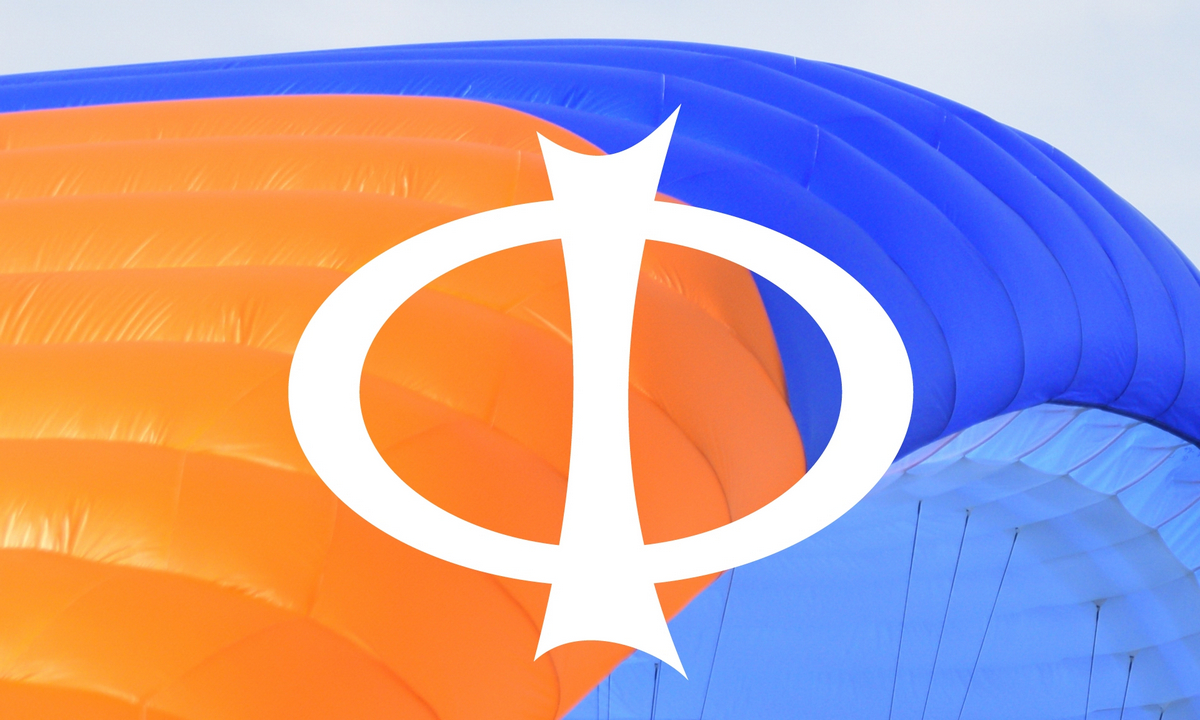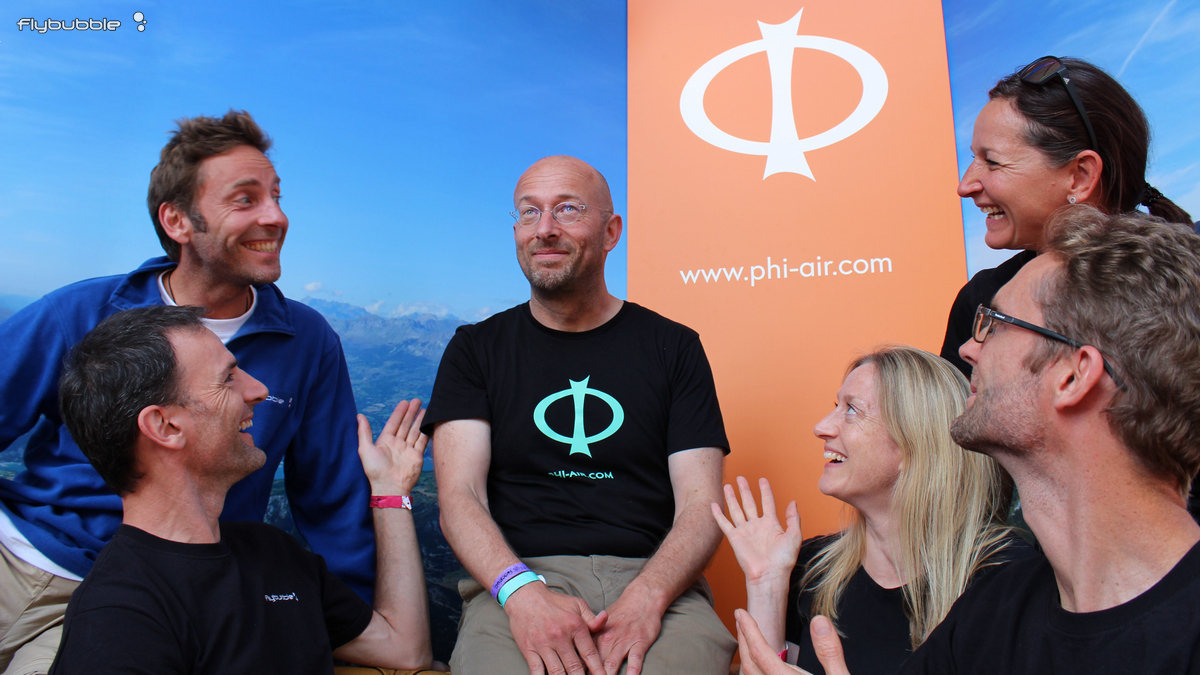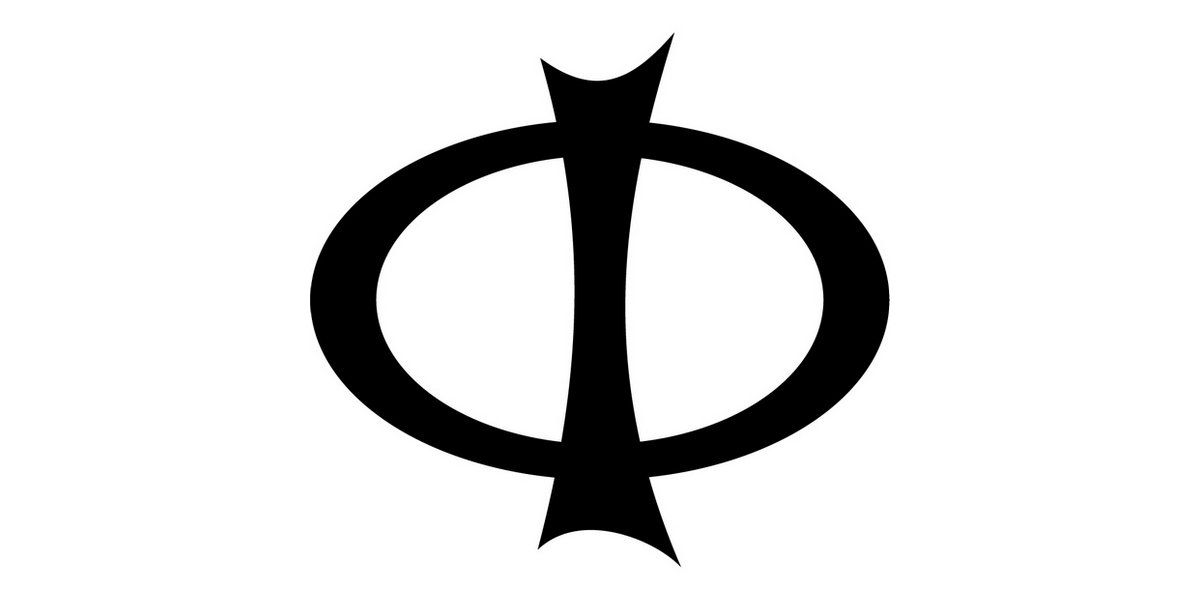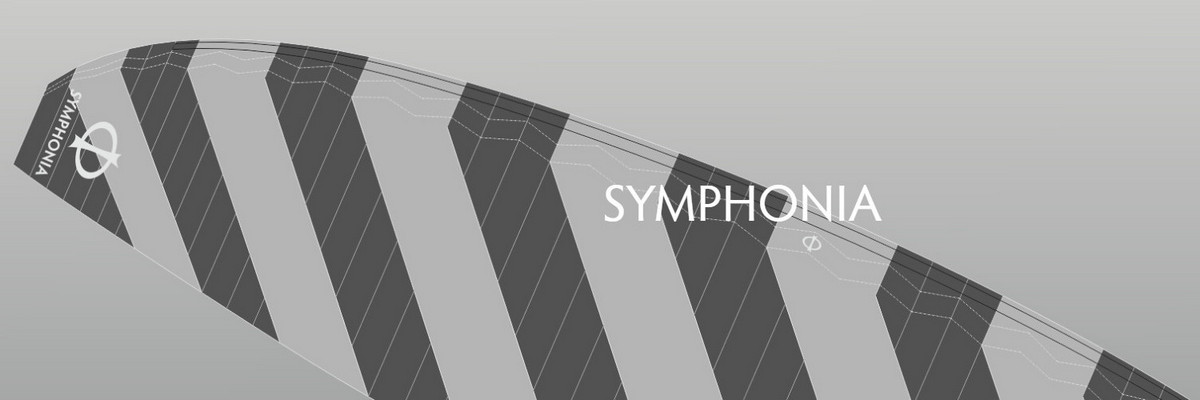
PHI has arrived!
Hannes Papesh, the wing design wizard with Nova from 1989 until 2013, and most recently involved in development at Advance, is releasing an eagerly anticipated new range of wings under the brand name PHI. (Pronounced as in 'Fee'.)
Hannes has a great reputation as a wing designer, and is held in high regard in the paragliding fraternity having been designing paragliders for nearly 30 years, during which time he has brought through some revolutionary ideas and innovations (see Hannes Papesh history below), which is just one reason why we are pleased to be bringing his new wings to the UK.
The other reason we’re so pleased to be representing PHI - and one which is potentially of more interest - is the focus they are taking with their range of wings.

We sat with Hannes at the Coupe to discuss the PHI difference. Despite the competition for our ears, (no we weren’t being interrupted by other manufacturers, but instead having to shout over a very loud drumming band which made a bee-line to where we were sitting) we gleaned much fascinating information…
PHI name & logo
Before moving onto the gliders, first a note on the slightly unusual name. The name PHI has the initials of Hannes Papesh within it, while the symbol for PHI used in the logo Φ is commonly used to represent the golden ratio, an irrational number with very significant and magical geometrical properties revered by classical architects and found throughout nature in fractal growth patterns.

PHI team & philosophy
Something which sets PHI apart from most other manufacturers, is in purposely staying small and beautiful, as well as ‘saving money on marketing to prioritise glider development.’
With this in mind, Hannes has carefully put together a small but highly experienced team. He is PHI's designer and CEO. Test pilots are Mike Kung and Benni Horburger. Other staff take care of the office, marketing and communications side of things.

Hannes is keen to point out that PHI is not like other paraglider brands:
"PHI is different in many ways. To begin with, this otherness is reflected in our workflow. Our team consists of well experienced personalities with major know-how in freelance business operations. Some of our team members shaped the paragliding industry before. Others joined only recently to enrich the vision of PHI. Challenges are our strengths, and backed up by modern digital solutions, PHI is thriving due to our complementary teamwork.
Uncompromising paragliding development as our core activity also demonstrates that we operate differently. Hasty developments and product launches on short notice are not our mission. We take all the time we need to ensure extraordinary performing paragliders close to perfection. In this context there is no space for incalculable experiments. Only approved materials are used to create our reliable and durable gliders. It is our goal to set new standards for paragliding in all categories according to our maxim: “simple and safe free flying for everyone”
We are looking forward to presenting you all our results in the most honest and plain way - precisely because PHI is different.
But be sceptical – nothing else can give you a better impression than your own test flight!"
PHI wings
Now, onto the wings! Hannes told us he believes that with the performance increase of modern wings it is no longer necessary to make compromises on the aspects of handling which bring about more predictable collapse and recovery behaviour, and it is now more interesting and of far more value to pilots to retain the safety while still not compromising on the potential for flying distance.
Many people have a desire to make the sport safer, however Hannes is taking this concept further than most by launching PHI with a range of three EN A rated wings. There are other category wings in the pipeline as below, but having 3 wings in the A category is so far unique.
That approach is newsworthy and one which could have a real impact on the perception of wing progression and the general level of safety recreational pilots experience in our sport.
The three EN A rated wings in PHI's range will comprise:
- Symphonia – the 'super-high A' wing, with low-mid B performance and handling!
- Sonata – a 'classic A' wing, designed to be a first purchase for graduate students
- Fantasia – a super-safe A wing for schools and pilots prioritising safety and cost
Symphonia lowdown
As PHI call it ‘a state of the art B wing with an EN A rating’ it’s the Symphonia which really caught our attention, plus it is the wing which is initially likely to appeal to the widest section of the market.
So, we asked Hannes to explain more fully the philosophy behind this design. Hannes told us he uses many computerised simulations to allow a minimal number of prototypes to be made prior to production. It is the light weight of the glider and the construction, including sliced diagonals, plus attention to detail in aspects like the smoothness of the seams which gives the combination of safety and performance. It comes with unsheathed lines, 50 cells with diagonal finger straps construction.

With this wing, PHI is taking a unique approach in bringing the more expensive manufacturing and construction techniques of the ‘higher’ classes of wing into the A category, as well as bestowing a lightness of handling and agility found in the B category. It is perhaps a more understandable approach to the market in mainland Europe where the wing most pilots first purchase is in the A class, unlike the UK where many pilots skip this step and move straight onto a B - rightly or wrongly.
The Symphonia is light, using high quality 32gm Porcher cloth for the top and bottom surface, while much work on the internal structure has reduced the number of nylon shaping rods allowing the 22 size to come out at only 4.5kg. Hannes describes the handling as ‘not A class’ being quick to react to brake input and with a particularly wide speed range with up to 17 cm of accelerator travel on the larger sizes.
Hannes told us that the Symphonia could easily have been developed as a very competitive B rated glider, but he feels strongly that giving pilots a range of wings to progress on, all within the A class will encourage pilots to retain the benefits of easier collapse recovery and a lower pilot workload.
Symphonia details
The Symphonia has been brought to market with absolutely no rush, and PHI took their time to ensure reliability under harsh conditions.
Hannes has done extensive testing with different line materials and sizes, and different combinations of lines in different areas, to best suit relative stresses, so as to arrive at a solution which is efficient yet very trim-stable. This means that the wing will keep flying as originally designed - maintaining it's original launch, flight, stability, recovery, handling and performance characteristics - for longer. Considering that in reality many pilots don't get their wings serviced (let alone re-trimmed) regularly enough, this has important positive safety implications. Many pilots will also appreciate the convenience of not having to send their wing off to an authorised service centre after only 15 to 20 flying hours and pay for it be checked and re-trimmed.
That the Symphonia is not a beginner wing is emphasised by the pricing, which at around €4,150 (exact pricing to be confirmed) is indicative of the complexity of construction and high quality of materials used. The Symphonia comes in 5 sizes from 18-26, indicating their projected surface area in m². The first wings are expected to be available in November, perhaps sooner.
Stock will be held and if necessary wings repaired in Europe, as shipping then does not need to be outside of the continent this gives customers the benefits of a much quicker ordering process and allows PHI to offer a one year warranty including any and all repairs from accidental damage.
The wing comes in a range of chevron designs (which are striking, if not a slightly acquired taste), while it is also possible to specify custom-schemes with control over the colour of every single stripe. The PHI rucksack also gains some innovation. Hannes explains most rucksacks are only used to get the wing to launch and don’t need to be built nearly as robustly. Weight is the more important factor therefore the bag shipped with all new PHI gliders weighs under 450g. If someone wants a more substantial rucksack then they can order this separately.
Find out more about the PHI SYMPHONIA
What's coming next?
The next wing for release which the PHI team are working on is the Sonata. This is a normal mid-level A wing like, for example, the Advance Alpha 6. The Sonata has 40 cells, is constructed from robust 30D Dominico cloth, and will sell at a normal price for this level of wing. The Sonata shares some important similarities with the Symphonia. For example, it has very good handling and extremely good launch characteristics. It has similar lines, simply because they are very trim-stable (the upper lines are unsheathed). The Sonata also has sliced diagonals (which Hannes calls "trompets") like the Symphonia. The performance of the Sonata is of course not as good as Symphonia, which is designed to be exceptional for an EN A wing, but still very good. "Still maybe too good!" says Hannes.
Hannes is also working on the Fantasia - a simple, ultra-safe, low cost wing. The Fantasia is aimed primarily at schools but also pilots with a restricted budget, so will be very cost efficient. Made from Dominico cloth, the Fantasia's lines are also very strong and durable.
Also in the works is a tandem wing based on the Symphonia, the Concerto (in fact, the Symphonia design was initially based on a prototype for a motor trike wing, but that’s another story).
If all goes to plan then next year will also see PHI launch a low-B wing, the Tenor sometime in spring and a high-B wing, the Maestro towards the end of the year, once again with the intention to bring the performance of higher class wings into the safer EN categories. In the Mentor range created whilst working with Nova, Hannes carved a reputation and a niche for himself with High B’s being his speciality. After working for Advance for the last 3 years Hannes is now very much looking forward to having a free reign to create something he intends to be ‘really very special’.
Whether the PHI approach strikes the right note in an image sensitive market remains to be seen, but we at Flybubble very much hope Hannes sets a trend in emphasising the real and tangible benefit of pilots flying safer aircraft even when our skill levels improve and covering long distance becomes our aim in taking to the air.
Hannes Papesh history
A summary history of Hannes Papesh, leading up to the formation of PHI:
- 1988 Hannes made his own paraglider using his mum's sewing machine: getting the Comet CX (very successful comp and world record wing).
- 1989 Nova brand started, their first wing designed by Hannes (Nova CXC).
- 1991 Hannes designed the Phantom with unique construction and extraordinary performance; it set a new world record, with the first flight over 200km!
- 1993 Hannes designed the Sphinx, which consolidated Nova as the leading manufacturer of high performance and competition wings. (Mike Kung joined Nova, later to become a test pilot for the DHV for some years, now a test pilot for Phi.)
- 1994 Hannes proved he could also achieve outstanding performance in the intermediate class; despite a remarkably simple design, the Phocus was top of its class.
- 1995 Hannes' next design, the Xenon competition wing, was nothing short of revolutionary, introducing diagonal rib construction to paragliding for the first time, allowing for a drastic reduction in total lines and drag, and a huge jump in performance. All other wings were left in the dust!
- 1996 Hannes' next design, the Xyon, had the same diagonal rib construction, and the same class beating performance. In fact it the beat all of the other competition wings too; the only wing that could beat it was the Xenon!
- 2001 Hannes was the first paragliding designer to use not only (self-written) computer programmes, but also professional simulation software for wing development. Using Computational Fluid Dynamics simulations (CFD) for the first time represented a milestone in paragliding design.
- 2005 the high-end DHV 1–2 (roughly equivalent to today's high-end EN B) Mamboo offered exceptional glide ratio in its class with surprisingly dynamic, direct handling. The big success with pilots and XC leagues, across all classes, was a sign of things to come!
- 2007 With the IBEX Hannes introduced a completely new paraglider concept, especially for mountaineers / Hike & Fly: small wings that could be flown with high wing-load due to their safe profile. For experienced pilots, it offered a lot of fun because of its high agility and it had a wide range of applications – from high alpine descents to soaring flights where the wind is a little too strong for a full-sized paraglider. Nowadays we might also call a wing like this a Mini Wing.
- 2007 the Mentor, the Mamboo's replacement, was a huge success in terms of both sales and XC leagues! So much so that Nova later decided to retain the Mentor name for all their 'high-end DHV 1-2' gliders.
- 2009 Nova introduced a lightweight version of a wing for the first time: the Oryx, a light version of the Mentor. In a similar vein to the Mentor, the low-end DHV 1-2 (roughly equivalent to today's low-end EN B) Ion series was launched.
- 2010 Nova launched the Mentor 2, certified EN B, with a new profile and a completely revised line geometry, mini-ribs in the trailing edge and kink-resistant polyamide rods for the first time. The Mentor 2 offered a new level of performance in its class, tempting many to step down from hotter wings. It dominated XC leagues in its class, and beat many much hotter wings. Many flights were done on the Mentor 2 that were previously not thought possible on this level of wing!
- 2012 Hannes achieved a similar feat in the low-end EN B category with the Ion 2. Nova began a cooperation with Advance, covering the areas of development and production. Advance provided extra production capacity and expertise in harnesses, Nova provided Hannes' expertise in wing development and CFD simulation software.
- 2013 the Mentor 3 brought the highest performance gain ever achieved between two generations of Nova wings, even though the basic technical data was identical to its predecessor, made possible by a number of optimisation measures. Numerous huge flights, XC domination and various world records proved the actual flying performance of the Mentor 3.
- 2014 after 25 years, to the surprise of the flying community, designer and co-founder Hannes left Nova and helped Advance to establish a new, young development team.
- 2017 Hannes left the Advance consulting cooperation to set up PHI.
(Also see Nova milestones)

